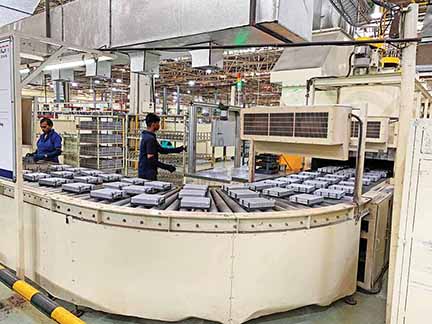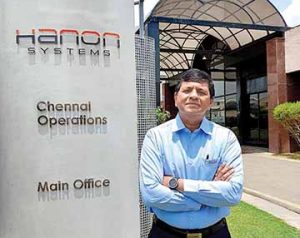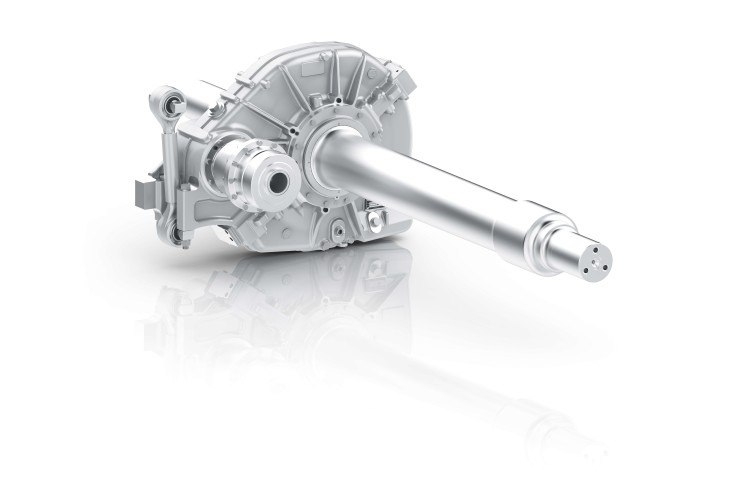Korea-headquartered Hanon Systems has set its sights on becoming a leader in innovative thermal and energy management and in developing sustainable solutions. Its Indian subsidiary Hanon Automotive Systems India (HASI) is also pursuing the same aspirations. HASI currently has 5 plants for its regional spread in India and 2 Engineering Centres to develop new thermal management systems and products. In an interview Murali Vaidyanathan, Managing Director – India, Hanon Automotive Systems India Pvt Ltd, told Bhargav TS that the company had chalked out plans to support its customers in India and abroad with its innovative products that meet the current and future needs of the OEMs. Edited excerpts:
Q: How do you view the current auto industry and what is your forecast for the next 1 year?
Murali: The year 2020 will be difficult and there will be a pre-buy happening towards the end of 2019. We have not seen this for the past 8 years. We have held on till now, and obviously, some plants depend on customer and model. Some models have done worse than others. Overall, we will be less than what we had budgeted. But we have been holding on as of now. We expect to have a significant increase in exports from this year.
Q: Are your exports direct or deemed?
Murali: For us the Hyundai supply is deemed export. They sell models overseas and we sell them. We do sell Hyundai parts directly to our sister companies who assemble and sell, but that is a small portion of it. Most of the exports are direct export, which is increasing tremendously. In some instances that has been hit more than what we expected. In some pocket we have been with diesel and that has been hit. It is a mixed bag. Overall, exports support the domestic market. We have to wait and watch to see what is going to happen for the current year.
Q: So the market is bumpy; in addition to this, new norms and trends are under way. How do you plan to move forward?
Murali: I do not think we have a specific plan for 2019-20 and we do not work that way. Overall as an organisation we see there will be a growth in the Indian market beyond the next 18 months. India is an important market for us and our investments prove that. It is quite competitive to make here and export. That is also being recognised. There are some products which are brought here and are being made here and exported. If you see the last 3-4 years, this has grown very significantly. So we would be around 15-20% as per our plan for the next 3 years.
Q: Does it mean that you have brought some products here to manufacture and export?
Murali: Yes. Many products are made in India for the export markets. They are not new products. For example, compressors; what we make here are not for the domestic market. Similarly we have a transmission oil cooler, both air-cooled and water-cooled, which is not used in the Indian market. But it is made here and exported.
Q: Are you bringing new technologies to the Indian market?
Murali: Technology for the market depends on what could be made here. We observe the market to see what technologies are being adopted more and more. Based on that, we get them here. We have made India as a hub for ‘Fixed compressors’ so we have increased the capacity two and a half times from half a million and it will be inching ahead further. It’s as per the business plan and probably it will go up even higher. So, by doing this we have ensured that there are many subscale operations, which have been brought together.
We brought a line from Thailand and a line from our facility in China, which is migrating to variable compressors in a big way. A good portion of it is exported. When we do all these, we ensure that we have a very high degree of localisation and we have a high degree of vertical integration. All of these together have ensured that we are competitive and we should be in a position to compete in the global market with enough volumes.
Q: So when do you see India move towards variable compressors?
Murali: We will observe and we can support the market immediately since this technology is available with us. We would like to exercise the option once a certain scale picks up in terms of variable adoption. We have not seen that trend very clearly in India. There are some OEMs which are moving to variable and some move to fixed compressors. We are ready for any new technology. Be it electrification, we are one of the few tier-ones who are out there in terms of being an early mover. We are supplying for many electrified products. The technology is very easily available for adoption. So, as we see the trend which is catching up here, we would be in a position to quickly adapt those technologies and make investments and move on. So, we do not see a problem in terms of a pipeline of technology for us.
Q: Can you throw some light on the thermal system for electric mobility. How is it going to be and how efficient is your product?
Murali: In an electric vehicle there are 3 to 4 important criteria. One is on how to minimize the power drawn as it will have a significant impact on the range. Second, the conventional cooling system has to be adopted to ensure we have an electric compressor and have parts of the system which are made more efficient to completely suit an electric vehicle. The third is going beyond, for example, there are batteries which need to be cooled and where we have complete battery cooling solutions. For thermal systems, in our space the content per vehicle is going up. This is positive for us. There
are disruptions to the entire auto industry but we feel that we are in a positive position.
Q: As a constant requirement, OEMs are looking for compact and lightweight systems. As a thermal systems manufacturer how do you address it and are there any innovations happening at Hanon?
Murali: Lightweighting has been a trend for so many years and as you mentioned it is a continuous exercise. Light weighting is what all the thermal manufacturers are competing for. We have a 10.8mm radiator, which is the slimmest in the market. We have a condenser which is 12 mm. So compacting and making it more efficient has been a trend. These systems may look bulky, but they are not heavy. They are becoming more and more efficient. For the last 5-7 years we see a trend of more compact, lightweight, efficient going into all parts of the system. So globally, we are investing on lightweighting and will come up with products then and there.
As we move further, I think we have certain visibility. There are technologies which will change from now and new systems will be required. The requirement is for systems to be controlled within a very narrow range. For example, the battery which has a very narrow range within which it is to be controlled. So, the need for more efficient and more accurate thermal management system is on the rise.
Q: How strong is your R&D team in India? What kind of patents have Hanon Systems filed so far?
Murali: We have 2 government recognised R&D centres, each in Chennai and Bhiwadi. Many of our evaluation development is done locally and it will increase. We do have a CAD, CAE Center in Pune and that will grow. That is catering to our global needs. So we will continue to invest in capability in India and other markets. We have a very judicious mix of core development and the regular development of our applications. So, we have 4 centres across the globe in Europe, the US, Eastern Europe and Korea. They work not only in terms of what we would like to do in each region but also what the customers would do.
For example, if our main customers do a certain amount of work, that is little point for us to do core work. We can still do core work for our own needs. That is a different story. So we need to match the requirement of the market. Innovations are being done and patents are being filed. We already have a few being done between Bhiwadi and Chennai. But they are all done for very specific purposes.
As an organisation, we have a record number of patents and we invest a lot. Innovation is the key to us. We understand that the automotive market is undergoing a very major transformation. We are on the cusp of it and we have ensured that we are covered. Be it ICE, electrification, hybrids even fuel cells we have products all across. So, we are in a position to cater to every vehicle needs. We are getting prepared for it and will be completely prepared once it comes in. So, we are looking at this change as very disruptive and we see more opportunities.
We are investing globally and in India also. We want to ensure that we are completely self-reliant on product evaluations of what could be done in terms of product improvements and product innovations. We had a huge amount which we had already invested in. We have invested for the compressor line, HVAC Tech, heat exchanger technologies etc.
Q: Are you looking at expanding your product base?
Murali: We are one of the two full-line suppliers of thermal solutions globally. We recently acquired the fluid division of Magna. This has significantly expanded our portfolio, not only in width but also in depth. In terms of depth, we also have acquired technology for brushless DC motor. That is useful for all the new range vehicles which are coming in, we have not seen the trend very clearly in the Indian market, but I am sure it will come in the near future.
Q: So when the BS VI migration happen what kind of changes will be need for the thermal systems?
Murali: The direct technological impact of BS VI on us is quite less. I think the adoption of a certain portion of EGR cooler is going to be much higher even in gasoline. Cooling the engines has been there for a long time. So, there is no specific BSVI requirement. It depends on the manufacturers.
Q: Engine downsizing is a new trend. How Hanon Systems is catering to that?
Murali: It has been a continuing trend. I think the regulations and OEMs have been driving it. If you want the weight to be reduced, the thermal system is kept in line with that requirement or even beyond that.
Q: You are present in the passenger car segment. When will Hanon enter the commercial vehicle area?
Murali: We are studying that part too. The reason why we are not present is more of a legacy reason. Our parentage has been mainly for passenger cars and passenger vehicles. There is nothing which prevents us from looking at commercial vehicles. We are studying the segment continuously, specifically for the Indian market as it is very big. There are very few centres where the growth of commercial vehicle will take place in a big way. We will look at it.
Driver comfort is being talked about for some time now. Commercial vehicles have AC cabins as a standard fitment. So, the thermal movement is moving up in the commercial vehicle segment. We are a player in LCVs and that will continue. I think the cabin space is important. The people who are using the vehicle will take it more sophisticated. So, the need for training people is a must. It is no longer going to be any unemployed youth driving a CV.
Q: Are you looking at increasing your content per vehicle?
Murali: Electrification and the future requirements of the industry will take it up. As of now, we are in the thermal space and we have a wide range of products already in the thermals. Our mission and vision statement says we will be there.
Q: How would you rate the Indian component industry?
Murali: There are a few things about the Indian government and the Industry. One, the quality level has gone up but it is with Tier – I. There is an obligation required as Tier-II is down. The OEMs face less issues with Tier-I but with Tier-II. If you see in terms of statistics how do I ensure that the large amount of Tier-II and Tier-III efficiency is going down? This is an important question. Many are addressing this and it should become more efficient.
The second is that exports are growing. But I am not sure about the potential. It could be larger in terms of what could be exported from here. Once we make in India, we can talk about developing in India. So it is always a step in that direction. It depends on the requirements. But, overall if you see in terms of capability, there is a certain amount of R&D capability required to even know the products and minutely for the build to print. If you have to do make to print, I don’t think we have a situation where you can have no R&D. Tier-I is very rarely built to print now. Because, if you see the structure of the industry, a certain portion of capability has already been subcontracted. ACI









Leave a Reply